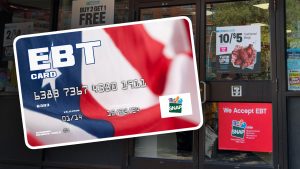How SNAP theft, ‘antiquated’ EBT cards feed global crime and starve victims

The longest-running government shutdown may be over, but the fight about the Supplemental Nutrition Assistance Program (SNAP) will likely rage on. The roughly $100 billion-a-year program, which helps nearly 42 million people buy groceries, was thrown into chaos during the standoff, leaving many low-income families scrambling for their next meal.
Agriculture Secretary Brooke Rollins, whose agency oversees SNAP, described the program as “so bloated, so broken, so dysfunctional, so corrupt.” Prominent Democrats charged that suspending food aid was cruel and vicious.
But beneath the partisan crossfire, most experts agree on two fundamental points: Millions of vulnerable Americans rely on SNAP, and the program’s flaws increasingly allow bad actors to steal taxpayer funds meant for those in need.
How easy is it to steal SNAP funds?
Rollins said her agency has uncovered “massive fraud” throughout SNAP, and is removing from the rolls hundreds of thousands of unauthorized immigrants, dead people and recipients who lied about their identity, income and family size, or who illegally filed for benefits in multiple states. She cited a Government Accountability Office finding that $10.5 billion in SNAP funds was improperly paid out in 2023 alone, accounting for approximately 12% of total SNAP payments that year. This type of fraud accounts for the bulk of abuse in the system, experts told Straight Arrow News.
But increasingly, SNAP funds are also drained by sophisticated criminals who steal from legitimate recipients and rarely get caught.
SNAP theft surged during the COVID-19 pandemic, when benefits were temporarily enhanced, and continues to grow, said Andrew McClenahan, senior director at LexisNexis Risk Solutions and a board member of the United Council on Welfare Fraud. Criminals are becoming more organized and technologically advanced, while SNAP continues to employ “antiquated rules, systems and equipment,” McClenahan explained.
These criminals use three primary methods to steal from SNAP, including skimming the benefits by pulling data from the Electronic Benefits Transfer (EBT) cards via devices installed on card readers; phishing schemes that trick people into revealing their SNAP data; and card cloning, which involves transferring someone’s data onto a new card for use.

“EBT cards use 1970s security measures,” said Greg Mahony, president of the California Welfare Fraud Investigators Association. Many EBT cards lack a chip — now standard on credit and debit cards — and rely on easy-to-hack magnetic stripes and simple PIN numbers.
Just one skimming device left in place for two weeks — typically without the store owner’s knowledge — can plunder about a thousand EBT cards, according to McClenahan.
EBT card swipes leave scant evidence for law enforcement trying to “follow the money,” said Dr. Mark Haskins, former Branch Chief for the Special Investigations Unit at the USDA. While credit card transactions are typically processed through merchant banks, which can result in records and delays, EBT purchases clear instantly through card readers that criminals have learned to sabotage, Haskins told Straight Arrow News.
Mahony put it bluntly: “I would never use a bank with such lax safeguards.”
Rollins’s office did not immediately respond to Straight Arrow News’ request for comment.
How has SNAP theft ballooned into a global enterprise?
SNAP thieves were once small-time operators who lived in their victims’ neighborhood and snatched modest sums, McClenahan said. Today, food aid stolen from vulnerable Americans flows to some of the most dangerous crime networks in the world, where it funds drugs, money laundering and human trafficking, experts said.
Last year, multiple law enforcement agencies arrested 48 alleged members of a Romanian crime ring accused of using skimming devices to steal hundreds of thousands of dollars in SNAP benefits from low-income Californians. The suspects allegedly used the stolen funds to buy baby formula, which they sold to drug cartels in Mexico during a formula shortage. Since that bust, similar alleged schemes tied to Romanian nationals have been uncovered in New York, Pennsylvania, Louisiana and other states.
SNAP theft was once primarily handled by local law enforcement, Haskins said. Now, the Secret Service, FBI and Department of Homeland Security are involved, “which tells you something about how transnational these crimes have become.”
Can victims recover their stolen SNAP aid?
While criminals profit from this hijacked food aid, vulnerable families are left in crisis. Under current law, stolen SNAP money is generally not eligible for replacement with federal funds, although some states offer partial relief.
“SNAP is the most effective anti-poverty program we’ve ever had. Now it is under attack from thieves and from our own government,” said Laboni Rahman, an attorney with The Legal Aid Society.
Rahman helped file a class action lawsuit against SNAP administrators, in which her clients sought replenishment of stolen benefits. Her clients include a low-income caregiver on disability, a mother fleeing domestic violence and a mother of six with two disabled children.
Victims typically discover their benefits are gone when their EBT card is declined at the grocery store, Rahman said. Some clients have been targeted multiple times and live with constant uncertainty about their next meal. She agreed with security experts that EBT cards need stronger protections, but warned that SNAP’s flaws must not obscure its mission.
“We are talking about the most fundamental of human needs,” Rahman stated. “We as a society should do everything we possibly can to ensure it.”
How can we stop SNAP theft?
Experts who spoke with Straight Arrow News shared several measures that could boost the security of SNAP and EBT cards. They proposed requiring all EBT cards to use chip technology, designing cards that work only in the recipient’s home state, tightening rules for online EBT use, adding identity verification requirements, blocking easily guessed PIN numbers, and modernizing the program’s data systems and payment infrastructure.

These measures come with trade-offs, including higher costs, less accessibility and new burdens on SNAP recipients. However, a serious flaw with the current system, according to McClenahan, is that “every time we make something easier for legitimate recipients, we also make it easier for fraudsters.”
The post How SNAP theft, ‘antiquated’ EBT cards feed global crime and starve victims appeared first on Straight Arrow News.





